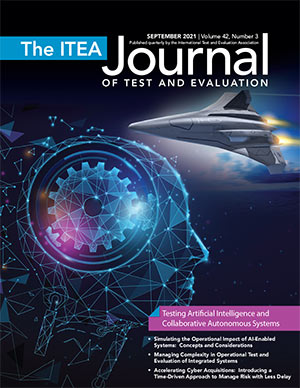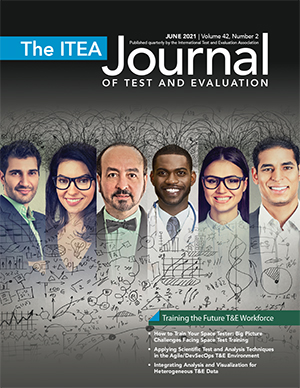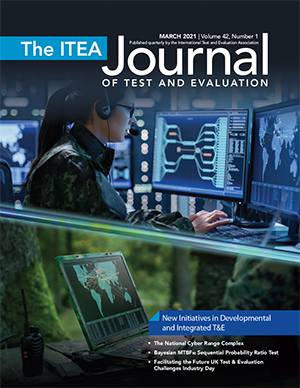2021 ITEA Journal Issues Abstracts
2021 ITEA Journal Issues Abstracts
ONLINE Issues (ITEA Members Only)
December 2021 – Success Stories in T&E

September 2021 – Testing Artificial Intelligence and Collaborative Autonomous Systems
 In this month’s Conversations with Experts, I had the opportunity to interview Jane Pinelis, Ph.D., Chief, Test and Evaluation, Department of Defense (DoD) Joint Artificial Intelligence Center. In this article, Dr. Pinelis reflects on her work in Test and Evaluation (T&E). She highlights the importance of interdisciplinary teams in T&E. She also highlights how Artificial Intelligence (AI) is bringing attention and excitement to T&E careers and the opportunity for new research.
In this month’s Conversations with Experts, I had the opportunity to interview Jane Pinelis, Ph.D., Chief, Test and Evaluation, Department of Defense (DoD) Joint Artificial Intelligence Center. In this article, Dr. Pinelis reflects on her work in Test and Evaluation (T&E). She highlights the importance of interdisciplinary teams in T&E. She also highlights how Artificial Intelligence (AI) is bringing attention and excitement to T&E careers and the opportunity for new research.
-
Selena Hamilton, James Hughes, and Virginia To, “Magical Machinations: A Virtual Reality Outreach Tool”
-
Tony Cruz, Chase Carbaugh, and Matthew Dwyer on “HPC Workload Characterization: Optimizing Data Ingestion and Initial Analysis of SCOUT Workloads”
-
Sean Leonard, Zhanping Liu, Ph.D., Simon Su, Ph.D., Luis Bravo, Ph.D., Anindya Ghoshal, Ph.D., Muthuvel Murugan, Ph.D., and Alison Flatau, Ph.D., “Application of CinemaScience Methods to Visualize and Analyze Complex Multiphase Flow Processes Supporting Next Generation Future Vertical Lift (FVL) Concepts”
-
Alexandra Le Moine, Alison Flatau, Ph.D., Simon Su, Ph.D., Luis Bravo, Ph.D., Anindya Ghoshal, Ph.D., and Muthuvel Murugan, Ph.D., “Deposition Models for CMAS (calcium-magnesium-alumino-silicate) Attack in Gas Turbine Engines.”
June 2021 – Training the Future T&E Workforce
Before we launch into The Issue at a Glance, I would like to take the time to thank our associate editors and publication team at The ITEA Journal. Associate editors provide recommendations for articles, conduct interviews, and keep ITEA’s content relevant to the Test and Evaluation (T&E) profession. We are currently looking for new associate editors. If you are interested in joining our team, or would like to learn more about what is involved, please let me know at journal@itea.org.
This month in our Conversations with Experts, J. Michael Barton, Ph.D., talks with Pete Christensen. Pete reflects on a career in the DHS and DoD. His advice to us all is, “Stick with It and Volunteer for Everything.”This issue, I am especially excited about our Workforce of the Future column.
Since this is a workforce issue, we are launching this new column, but it will remain a fixture for future issues. Our goal is to capture more papers from students (our future workforce) in The ITEA Journal. These papers could come from internship experiences, research projects, or experiential learning projects. The only requirement is that a student should be the lead author on papers in this column. This issue’s column features articles written by interns from the High Performance Computing Modernization Program (HPCMP) Internship Program. This program supports undergraduate and graduate student summer internship opportunities at DoD laboratories and test centers where students learn high performance computing skills. Virginia To provides a great introduction to this column. In “Future with Computing,” Virginia provides an overview of the DoD HPCMP Internship Program. The three articles that follow all come from last year’s summer internship program and include:
• James Hughes, Selena Hamilton, and Virginia To, “Immersive Environments for Visual Analytics”
• Aiden Kenny, Mariya Occorso, and Vincent Perry, “Visual Analytic Application Toolset for Large-Scale Data”
• Sage Leone, Jaime Infantolino, Adam Childs, and Cleon Anderson, “Topic Modeling and Visualization for Test Incident Report Data”
In our first technical article, “How to Train Your Space Tester: Big Picture Challenges Facing Space Test Training,” Michael Nayak, Ph.D., Christina Straight, Evelyn Kent, and Jarred Langhals discuss four of the big challenges that need to be addressed for a possible future “Space Test Pilot School,” and their impact on US Space Force operators.
In our second technical article, William Rowell, Ph.D., Steven Oimoen, Ph.D., Leonard Truett, Ph.D., and Timothy Shelton discuss, “Applying Scientific Test and Analysis Techniques in the Agile/DevSecOps T&E Environment.” The article provides guidance and illustrative examples.
In technical article three, Vincent Perry, Mariya Occorso, Aiden Kenny, and Dale Shires discuss “Integrating Analysis and Visualization for Heterogeneous T&E Data.” Their work is motivated by the convergence of autonomous systems and big data.
In “Test in the 21st Century: Enabling a Digital Workforce to Support Tomorrow’s T&E Needs,” Alexander Hillman and Rebeka Melber discuss the need for a data savvy workforce in this new digital era. They highlight the need for leadership support in developing, recruiting, and educating the evolving T&E workforce.
In our final article for this workforce issue, Shokoufeh Mirzaei, Ph.D., Erich Brownlow, James Brownlow, Ph.D., and Robert Poulson, Ph.D. discuss new methods for modeling tracking errors in “Stochastics Differential Equation Modeling of Target Tracking Errors.” They showcase how stochastic differential equations offer a solution to modeling systems whose output is autocorrelated and also converges to a specific value over time.



